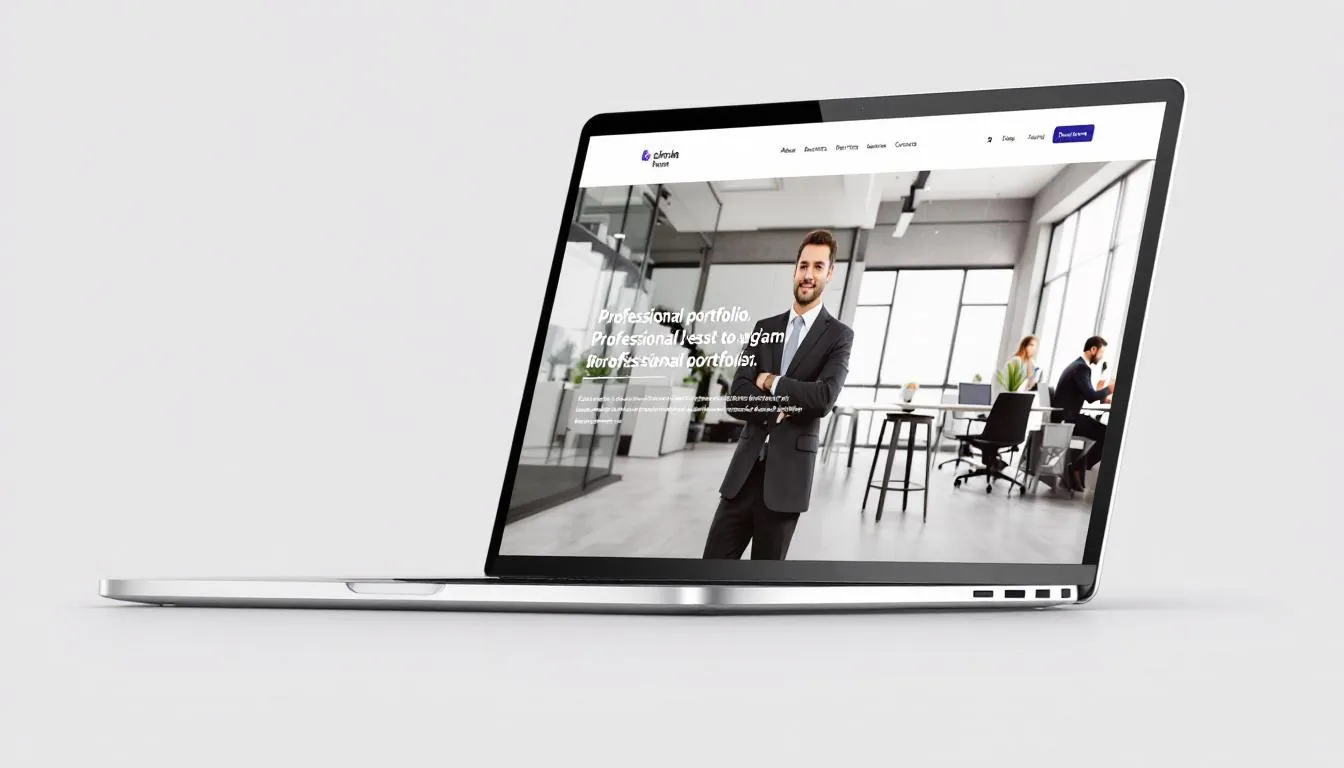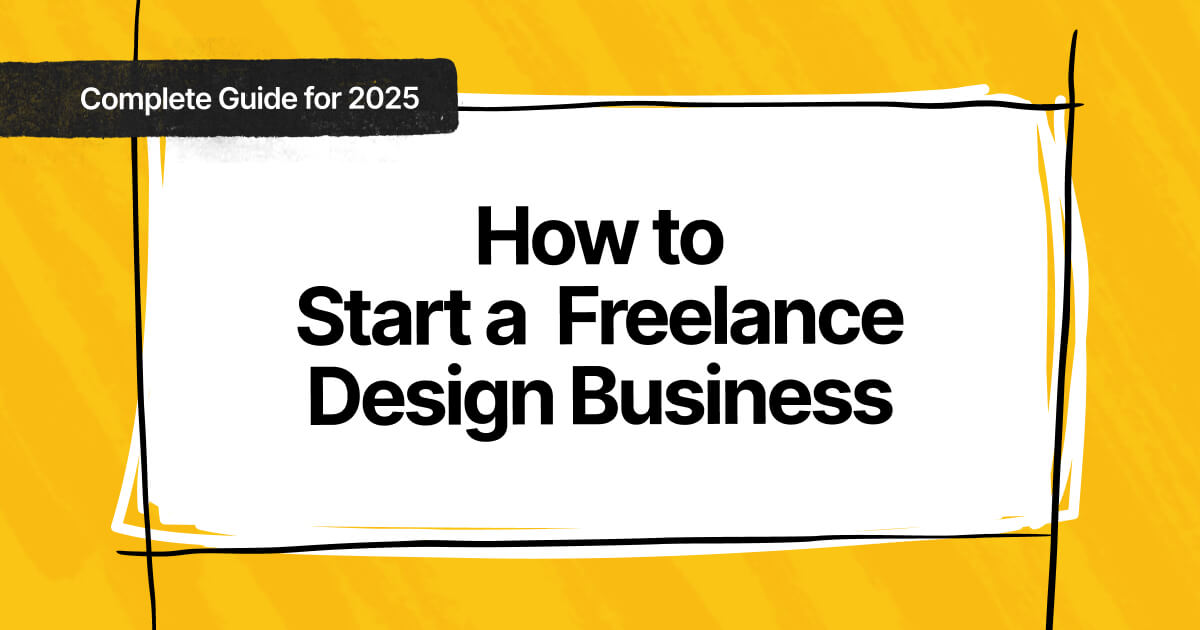Key Takeaways
- Register your business locally (e.g. Kamer van Koophandel in the Netherlands) and set up a separate business bank account.
- Build a professional portfolio site showcasing 6–8 of your strongest projects.
- Set competitive rates based on local market research and your experience level.
- Find your first clients through your network, online platforms, and referrals.
- Master business skills like client communication, project management, and marketing to stay in business long-term.
Starting your own freelance design business means you control your schedule, choose your clients, and decide how much you earn. You can work from anywhere — your home office, a co-working space, or a café in Lisbon — while doing work you actually enjoy.
The challenge? Most designers are great at the creative side but not so great at the business side. And that’s what makes or breaks a freelance career.
The European design market is thriving. Agencies and companies are hiring freelancers for flexibility and specialised skills — but only the ones who know how to run their business like a business.
This guide walks you through every step to launch your freelance design business in Europe — from legal setup to finding your first client.

Define Your Freelance Design Business
Before you conduct business or create your first business card, you need clarity on what type of freelance graphic design business you’re building. This foundation shapes everything from your marketing efforts to your target audience.
Choose Your Design Specialty
The graphic design field offers numerous paths. You can focus on logo design, web design, packaging, motion design, or branding. Some freelance graphic designers prefer being generalists who handle diverse projects, while others become specialists in specific areas like web development integration or social media accounts management.
Research shows that freelance graphic designers with clear specializations often command higher rates than generalists. A freelance graphic designer focused on SaaS companies, for example, can position themselves as an expert in that sector’s unique visual communication needs.
Identify Your Target Market
Your ideal client might be startups needing complete branding packages, established companies requiring ongoing design work, or local businesses seeking affordable graphic design services. Each market has different expectations, budgets, and project timelines.
Consider these factors when defining your target audience:
- Company size and budget range
- Industry knowledge requirements
- Project complexity preferences
- Geographic location (local vs. remote work)
Determine Your Service Offerings
Map out exactly what graphic design services you’ll provide. Will you handle web design projects, create comprehensive brand identities, or focus on print materials? Some freelance graphic designers also offer related services like web development or search engine optimization to increase project value.
Create a clear service menu that potential clients can easily understand. This helps with both pricing discussions and setting proper project expectations.
Set Up Your Business Foundation
The admin side isn’t glamorous, but it builds credibility and keeps you legal.
Register Your Business
In the Netherlands, register at the Kamer van Koophandel (KvK) and you’ll automatically get a VAT number from the Belastingdienst.
Elsewhere in the EU, you’ll register with your local chamber of commerce or equivalent.
Open a Business Bank Account
Keep your personal and business finances separate. Most European banks have freelancer accounts with low fees and solid online banking tools.
Understand VAT
If you’re in the EU, you’ll need to handle VAT on invoices — even for clients in other EU countries. Learn how the reverse-charge mechanism works for cross-border services.
Consider Professional Insurance
Not mandatory everywhere, but professional indemnity insurance protects you if a client claims your work caused them loss. Some larger companies require it.

Develop Essential Business Skills
Technical skills in Adobe Creative Cloud and design principles are just the starting point. Success as a freelance graphic designer requires business savvy and strong client communication abilities.
Master Core Design Software
Invest in Adobe Creative Cloud for access to industry-standard tools like Adobe Illustrator, Photoshop, and InDesign. Many clients expect familiarity with these programs, and most design agencies use them for collaborative work.
Add Figma to your toolkit for web design and user interface projects. This cloud-based platform is increasingly popular for collaborative design work and many tech companies prefer it over traditional Adobe tools.
Learn Business Fundamentals
Understanding invoicing, contract management, and project timelines separates successful freelance graphic designers from those who struggle financially. Take an online course focused on freelance business management or graphic design business operations.
Key business skills include:
- Time tracking and project estimation
- Client onboarding processes
- Revision management and scope control
- Basic accounting and tax preparation
Managing multiple clients and deadlines requires systematic approaches. Learn to use project management tools and create repeatable workflows that ensure consistent delivery quality.
Strong project management also improves client communication and helps prevent the scope creep that kills profitability on design projects.
Create Your Professional Brand and Portfolio
Your portfolio website serves as both your marketing tool and credibility builder. Potential clients judge your graphic design skills primarily through your online portfolio, making this investment crucial for your freelance graphic design career.
Design Your Visual Identity
Create your own logo and establish consistent branding across all materials. This demonstrates your design capabilities while building recognition as your freelance graphic design business grows.
Develop a cohesive color palette, typography system, and visual style that reflects your design aesthetic and appeals to your target audience. Use these elements consistently across your portfolio website, social media accounts, and business materials.
Build a Professional Portfolio Website
Your own website needs 6-8 high-quality projects that showcase problem-solving through design. Include diverse work that demonstrates your range while highlighting your strongest capabilities.
For each project, write compelling descriptions that explain:
- The client’s challenge or goal
- Your design process and decisions
- Measurable results when possible
- Technical skills demonstrated
Ensure your portfolio website loads quickly and works perfectly on mobile devices. Many prospective clients will first discover your work through social media accounts or job boards accessed on phones.
Optimize for Search Engines
Basic search engine optimization helps potential clients find your graphic design services online. Include relevant keywords naturally in your project descriptions and about page content.
Create individual pages for your main services (logo design, web design, branding) to capture searches for specific graphic design needs in your area.

Establish Your Pricing Strategy
Pricing affects everything from the clients you attract to how much revenue your freelance graphic design business generates. Research the market carefully and position yourself appropriately for your experience level.
Research Market Rates
Freelance graphic designer rates vary significantly by location, experience, and specialization. Entry-level designers might charge $25-50 per hour, while experienced specialists can command $100-150+ per hour for complex projects.
Study job boards and freelance platforms to understand current market rates. Connect with other designers through networking events or online communities to discuss pricing strategies.
Choose Your Pricing Model
Hourly rates work well for ongoing relationships and undefined project scope. Project-based pricing provides budget certainty for clients and often yields higher profits when you work efficiently.
Value-based pricing—charging based on project impact rather than time—can maximize earnings for experienced freelance graphic designers working with clients who have clear business goals.
Factor in All Costs
Remember that your freelance rate must cover more than design time. Include client communication, revisions, administrative tasks, and business expenses in your calculations.
As a self employed individual, you’re also responsible for health insurance, retirement savings, and self-employment taxes that employees receive as benefits.
Create Rate Sheets
Develop pricing guidelines for common projects like logos, brochures, or website designs. This speeds up proposal creation and ensures consistent pricing across similar projects.
Build in revision allowances and clearly define what constitutes additional work beyond the base project scope.
Create Business Systems and Templates
Efficient systems reduce administrative overhead and create professional experiences that differentiate your freelance graphic design business from competitors who operate more casually.
Develop Proposal Templates
Create standardized proposals that clearly outline your graphic design services, pricing, and project timelines. Professional proposals demonstrate business maturity and help prospective clients understand exactly what they’re purchasing.
Include sections for:
- Project overview and objectives
- Scope of work and deliverables
- Timeline and milestones
- Investment and payment terms
- Terms and conditions
Establish Contract Standards
Protect your freelance business with contracts that define project scope, revision limits, payment schedules, and intellectual property ownership. Every project should begin with a signed agreement, regardless of project size.
Address common issues like scope creep, late payments, and client approval processes upfront to prevent disputes later.
Set Up Invoicing Systems
Use professional invoicing software to track payments and maintain financial records. Automated systems can send payment reminders and help with basic accounting tasks.
Popular options include QuickBooks, FreshBooks, and Wave, each offering features designed for freelance businesses and self employed professionals.
Create Client Onboarding Processes
Develop questionnaires and welcome packets that gather necessary project information while setting professional expectations. Smooth onboarding experiences build client confidence and reduce project delays.
Include brand guidelines requests, content requirements, and preferred communication methods in your onboarding materials.

Find Your First Clients
Landing your first client often feels like the biggest hurdle in starting a freelance graphic design business. Focus on leveraging existing connections while building systems for ongoing client acquisition.
Leverage Your Network
Your personal and professional network offers the fastest path to your first clients. Former colleagues, friends, and family members might need graphic design services or know someone who does.
Create a list of everyone you know and systematically reach out about your new freelance graphic design business. Many successful freelance graphic designers report that referrals from their network provided their most valuable early projects.
Use Freelance Platforms
For more tips on routine, discipline, and support for creative freelancers, check out philipwallage.com.
Job boards like Upwork, Fiverr, and 99designs provide access to clients actively seeking graphic design services. While competition is intense and rates can be lower, these platforms help build experience and client testimonials.
Focus on creating compelling profiles that highlight your graphic design skills and unique value proposition. Bid strategically on projects that align with your capabilities and pricing goals.
Target Local Businesses
Many local businesses need graphic design services but lack connections to professional designers. Visit business districts, attend networking events, and research companies that might benefit from updated branding or marketing materials.
Local clients often prefer working with nearby freelance graphic designers and may offer opportunities for ongoing relationships that provide steady income.
Volunteer for Portfolio Building
Nonprofits and community organizations often need design help but have limited budgets. Volunteering your graphic design services builds portfolio content while creating networking opportunities and potential testimonials.
Choose volunteer projects that showcase skills relevant to your target market and allow creative freedom to demonstrate your full capabilities.
Manage Client Relationships
Strong client relationships fuel freelance graphic design career growth through repeat business and referrals. Professional communication and reliable delivery build the trust that separates successful freelance graphic designers from the competition.
Establish Clear Communication
Set expectations for response times, preferred communication methods, and project update schedules. Many client issues stem from unclear communication rather than design quality problems.
Use email for formal communications and project approvals, but consider phone calls or video meetings for complex discussions or relationship building.
Always Use Contracts
Every project needs a signed contract before work begins, regardless of client relationships or project size. Contracts protect both parties and provide clear reference points when questions arise.
Include specific details about deliverables, revision limits, timeline expectations, and payment terms. Well-written contracts prevent most client disputes and demonstrate professionalism.
Deliver Consistently
Meeting deadlines and quality expectations builds client confidence and encourages repeat business. Develop personal systems that ensure reliable delivery even when managing multiple projects simultaneously.
Communicate proactively if delays occur and always provide solutions rather than just problems. How many clients you retain depends largely on your reliability and communication skills.
Request Testimonials
Ask satisfied clients for written testimonials and reviews that you can feature on your portfolio website and social media presence. Positive reviews build credibility with prospective clients and differentiate your freelance graphic design business.
Make testimonial requests part of your project completion process while the positive experience is fresh in clients’ minds.

Scale and Grow Your Business
Building a sustainable freelance graphic design business requires ongoing marketing efforts and systematic approaches to business development. Focus on creating momentum through satisfied clients and strategic positioning.
Ask for Referrals
Satisfied clients often know other businesses that need graphic design services. Develop systematic approaches for requesting referrals and make it easy for clients to recommend your services.
Consider offering referral incentives or simply expressing appreciation when clients connect you with new opportunities. Word-of-mouth recommendations remain the most effective marketing for freelance graphic designers.
Continuously Market Your Services
Successful freelance graphic design businesses maintain consistent marketing efforts even when current clients provide steady work. Market conditions change and client needs evolve, making ongoing marketing essential for long-term stability.
Maintain active social media accounts, update your portfolio website regularly, and participate in design world conversations through networking events or online communities.
Stay Current with Trends
The graphic design industry evolves rapidly with new tools, techniques, and client expectations. Take online courses, follow design blogs, and study other designers’ work to maintain contemporary skills.
Consider specializing in emerging areas like motion design, user experience design, or accessibility-focused design as these skills become more valuable in the marketplace.
Raise Your Rates Strategically
As your experience and client base grow, gradually increase your rates to reflect your enhanced value proposition. Established freelance graphic designers should evaluate pricing annually and adjust based on market conditions and demand.
Communicate rate increases professionally with existing clients, emphasizing the enhanced value and experience you bring to their projects.
Consider Collaborative Opportunities
Partner with other freelance graphic designers, web developers, or marketing consultants to handle larger projects that exceed your individual capabilities. These relationships can provide steady work referrals and learning opportunities.
Some freelance graphic designers eventually transition into design agencies by building teams of collaborators for complex client needs.
Financial Management and Planning
Managing personal finances as a self employed individual requires different strategies than traditional employment. Build financial stability through careful planning and systematic money management.
Build Emergency Funds
Create an emergency fund covering 6-12 months of both personal and business expenses before transitioning to full-time freelancing. Freelance income varies significantly, especially during the first year of building your client base.
This financial cushion allows you to be selective about projects and avoid accepting low-paying work out of desperation.
Track Business Expenses
Maintain detailed records of all business expenses for tax deduction purposes. Common deductions for freelance graphic designers include software subscriptions, equipment purchases, office supplies, and professional development costs.
Use accounting software or work with a professional accountant to optimize your tax situation and ensure compliance with self-employment tax requirements.
Separate Personal and Business Finances
Keep personal finances completely separate from your freelance graphic design business operations. This simplifies tax preparation and provides clear financial tracking for business performance evaluation.
Pay yourself a regular salary from business income rather than mixing personal and business expenses casually.
Plan for Tax Obligations
Self employed individuals must pay estimated taxes quarterly rather than having taxes withheld from paychecks. Set aside 25-30% of income for tax obligations to avoid surprises during tax season.
Consider working with an accountant familiar with freelance businesses to optimize deductions and ensure proper tax planning.
Invest in Business Growth
Reinvest profits into better equipment, professional development, and marketing efforts that support business growth. Upgraded computers, additional software licenses, and industry conference attendance often generate returns through improved capabilities and client connections.
Balance current income needs with strategic investments in your freelance graphic design career’s long-term success.
FAQ
How much money do I need to start a freelance design business?
You can start with as little as $500-$2,000 covering basic software subscriptions, business registration, website hosting, and initial marketing materials. The most significant investment is often your time building a portfolio and finding clients. Essential costs include Adobe Creative Cloud subscriptions ($50-60/month), basic business registration fees ($50-200), and professional website hosting ($10-30/month).
Should I quit my job immediately to start freelancing?
It’s generally recommended to build your freelance business part-time while maintaining steady income. Aim to secure 2-3 regular clients and save 6-12 months of expenses before transitioning to full-time freelancing. This approach reduces financial stress and allows you to build client relationships gradually while maintaining your current income stream.
What’s the difference between working as a freelancer versus starting a design agency?
Freelancers typically work alone and handle all aspects of client work personally, while agencies involve hiring employees, managing larger projects, and focusing more on business operations than hands-on design work. Freelancing offers more control and potentially higher profit margins, but agencies can scale beyond individual time limitations and handle larger client projects.
How do I handle difficult clients or scope creep?
Prevent issues with detailed contracts specifying revision limits, project scope, and timeline. When scope creep occurs, politely refer to the original agreement and provide a quote for additional work. Always communicate changes in writing and maintain professional boundaries. Consider requiring deposits before starting work and building revision limits into your pricing structure.
What insurance do freelance designers need?
Consider professional liability insurance to protect against claims of errors or negligence, and general liability insurance if you meet clients in person. Some clients may require proof of insurance before hiring you for larger projects. Professional liability insurance typically costs $200-500 annually for freelance designers and provides protection against client disputes over work quality or missed deadlines.
Got questions?
I’ve got (real) answers.
Every month, I answer 3 questions from creative freelancers, indie founders, and solo designers trying to grow their business without losing their minds (or soul).

